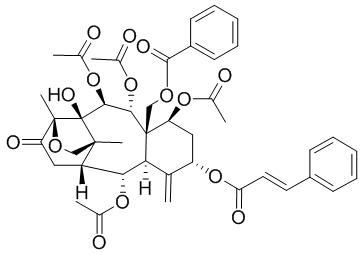Taxacin
Taxacin shows strong inhibitory effects on platelet aggregation induced by arachidonic acid (IC(50):21.9 microM). Taxacin can suppress the superoxide generation induced by N-formyl-methionyl-leucyl-phenylalanine (fMLP) and arachidonic acid (AA) in a concentration-dependent manner.
Inquire / Order:
manager@chemfaces.com
Technical Inquiries:
service@chemfaces.com
Tel:
+86-27-84237783
Fax:
+86-27-84254680
Address:
1 Building, No. 83, CheCheng Rd., Wuhan Economic and Technological Development Zone, Wuhan, Hubei 430056, PRC
Providing storage is as stated on the product vial and the vial is kept tightly sealed, the product can be stored for up to
24 months(2-8C).
Wherever possible, you should prepare and use solutions on the same day. However, if you need to make up stock solutions in advance, we recommend that you store the solution as aliquots in tightly sealed vials at -20C. Generally, these will be useable for up to two weeks. Before use, and prior to opening the vial we recommend that you allow your product to equilibrate to room temperature for at least 1 hour.
Need more advice on solubility, usage and handling? Please email to: service@chemfaces.com
The packaging of the product may have turned upside down during transportation, resulting in the natural compounds adhering to the neck or cap of the vial. take the vial out of its packaging and gently shake to let the compounds fall to the bottom of the vial. for liquid products, centrifuge at 200-500 RPM to gather the liquid at the bottom of the vial. try to avoid loss or contamination during handling.
Nutrients.2021, 13(12):4364.
Chemistry of plant raw materials2021, 1:pp 139-150
Cell.2022, 185(23):4298-4316.e21.
Kyung Hee University2024, rs-3888374
J Agric Food Chem.2022, 70(51):16176-16187.
Elife.2021, 10:e68058.
Exp Parasitol.2018, 194:67-78
Journal of Functional Foods2022, 91:105019.
Molecules.2019, 24(23):E4303
PLoS One.2021, 16(6):e0248479.
Related and Featured Products
Thromb Res. 2010 Jun;125(6):e281-4.
A comparative optical aggregometry study of antiplatelet activity of taxanes from Taxus cuspidata.[Pubmed:
20170941 ]
Platelets are highly reactive components of the circulatory system. The cytoskeleton of a platelet is an important structure for platelet aggregation as stimulated by several agonists. An anticancer agent, taxol, has been suggested to exert platelet anti-aggregating activity by stabilizing microtubules during the aggregation process.
METHODS AND RESULTS:
An activity-guided fractionation was performed with a methanol extract of the leaves and twigs of Taxus cuspidata to isolate taxanes with platelet anti-aggregating effects. Compounds 1 to 7 - taxinine (1), taxinine A (2), taxinine B (3), 2-deacetoxytaxinine B (4), Taxacin (5), taxchinin B (6), and taxol (7) - were obtained as the antiplatelet components of this plant. These taxane compounds present the possibility of securing new antiplatelet compounds which differ from currently available antiplatelet agents in chemical structure and possibly in mechanisms of action. All compounds showed stronger inhibitory effects than acetylsalicylic acid (ASA) on platelet aggregation induced by arachidonic acid (AA) (IC(50): 14.4, 64.5, 35.5, 16.0, 21.9, 28.6 and 48.2 versus 63.0microM) or U46619 (IC(50): 34.8, 24.9, 36.2, 35.0, 46.9, 71.9 and 68.7 versus 340microM). Compounds 1, 3, 4 and 5, with a cinnamoyl group at the C(5) position, showed strong inhibitory effects against AA-induced aggregation compared to compound 2 (with an -OH group at C(5)) or compounds with an oxetane ring at C(4),(5), such as compounds 6 and 7.
CONCLUSIONS:
All of the seven compounds were 5-13-fold more strongly inhibitory than ASA against U46619-induced aggregation.
Planta Med. 2009 Jun;75(8):814-22.
Effect of seven tricyclic diterpenoids from needles of Taxus media var. Hicksii on stimulus-induced superoxide generation, tyrosyl or serine/threonine phosphorylation and translocation of cytosolic compounds to the cell membrane in human neutrophils.[Pubmed:
19288401 ]
Taxol has been widely used as an anticancer drug for ovarian, breast, lung and prostate cancer. Some kinds of Taxus plants are widely distributed in the Northeast Asia region.
METHODS AND RESULTS:
We have isolated seven tricyclic diterpenoids, taxinine, taxagifine, 5-O-cinnamoylTaxacin I triacetate, 5-decinnamoyltaxinine J, 5-cinnamoyl-9-acetyltaxicin I, Taxacin and taxol from the needles of Taxus media var. Hicksii, and investigated their effects on stimulus-induced superoxide generation and translocation of cytosolic compounds to the cell membrane in human neutrophils. Six tricyclic diterpenoids used in this experiment suppressed the superoxide generation induced by N-formyl-methionyl-leucyl-phenylalanine (fMLP) and arachidonic acid (AA) in a concentration-dependent manner. Taxinine significantly suppressed the superoxide generation induced by phorbol 12-myristate 13-acetate (PMA).
CONCLUSIONS:
The compounds also suppressed fMLP- and AA-induced tyrosyl or PMA-induced serine/threonine phosphorylation, and translocation of cytosolic compounds, p47 (phox), p67 (phox) and Rac to the cell membrane in parallel with the suppression of the stimulus-induced superoxide generation.



